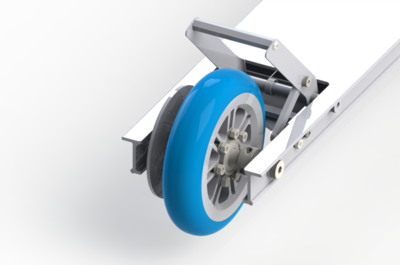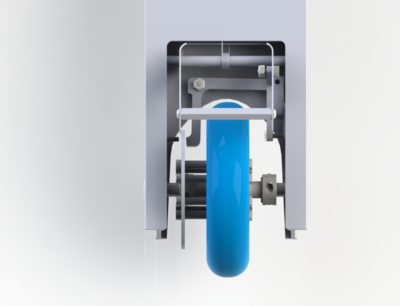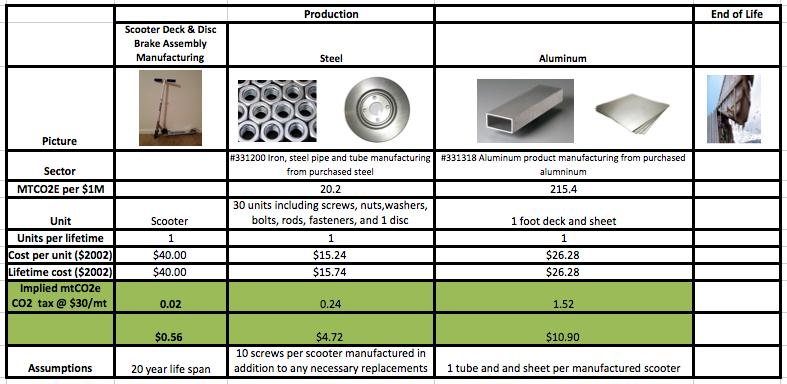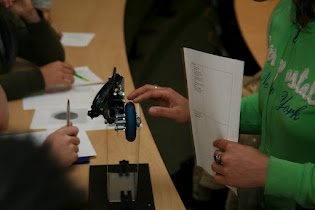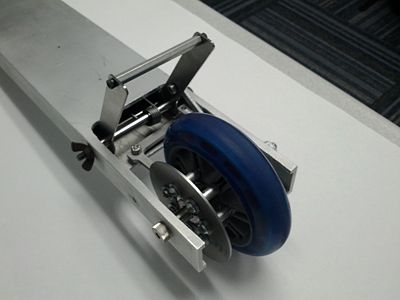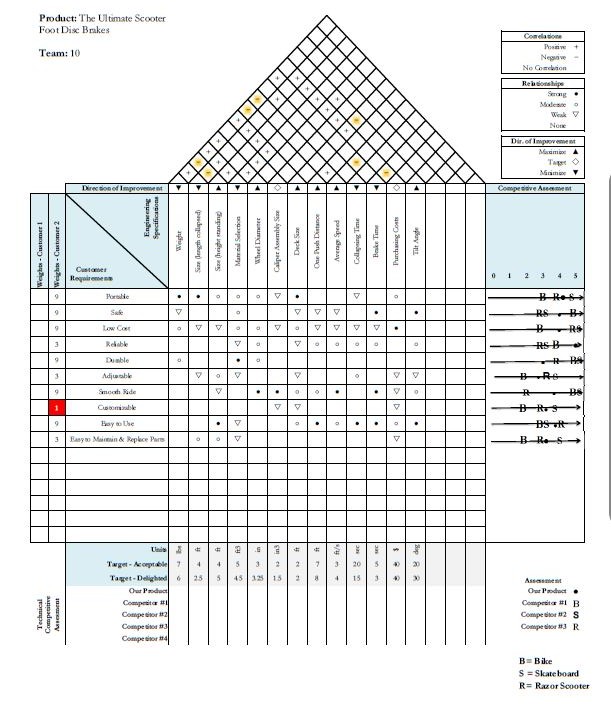Scooter innovation
From DDL Wiki
Contents |
Executive Summary
The product we chose to redesign was the Razor Scooter. Our initial analysis and user feedback showed several problems with the existing design. Users liked our competitor, the Razor, because it was lightweight, portable, and fun. They disliked the braking system, the inability to customize or repair their scooter, and the difficulty of use for larger riders. Our initial Design for Manufacture & Assembly Analysis showed that our competitor’s product utilized fairly simple designs, and could be easily tested in subassemblies, but had too many components, did not standardize components, and was extremely difficult to assemble. From a Failure Mode standpoint, the three main concerns we had about the safety of our competitor’s product were the rear wheel wearing down due to excess braking, the wheel axle bending due to excess loads, and the collapsing mechanism jamming. During our Environmental Analysis, we discovered that our product has effectively zero impact on the environment during its use phase, so they only way to make it greener would be to reduce its materials and manufacturing processes. Refer to either of our previous reports for more detail on our process.
We decided to focus on the brakes of the scooter, as they were a problem in both user feedback and failure analysis. To improve the performance of the scooter brakes, we implemented a custom disc brake design that provides an easy braking experience without wearing down the rear wheel in the process. We went through several prototypes, in which we tried to prove the feasibility of a disc brake design. User feedback at every phase helped us steer in the right direction: we needed a small brake that would provide an adequate amount of stopping force, feel good to the user, and not interfere with the size or functionality of the scooter. Therefore, our design has a customized foot pedal, which actuates a caliper that fits inside the deck of the scooter, and presses on a steel disc with ceramic brake pads to provide enough friction to stop the scooter in a reasonable amount of time without forcing the wheel to stop rotating, causing it to degrade over time.
We performed some mechanical analysis on our product to determine the brake time, braking force, and friction force applied to our final design. *Detail*
As compared to its competitors, our product has a price comparable to the higher-end scooters on the market, and improves on their performance. It does require some assembly, however, which users would dislike. It is still cheaper and more portable than a bike, but more expensive and larger than a skateboard. *Detail* As compared to our original product, our design for manufacture and assembly is actually a lot more difficult due to the addition of essentially an entirely new subassembly which includes many small parts. Where we did improve, however, was the standardization of components. We kept nearly every screw in our final product to a 6-32 thread, although they did necessarily vary in length. For our failure mode analysis, we have eliminated the largest problem, the rear wheel deteriorating over time. Since our scooter will probably have larger riders than the target market of our competitor, we accounted for increased strain on the rear axle by employing a stronger one in our design. Overall, we greatly improved on the failure modes of our competitor, while only adding a few risky pinch points, which it is clear our customers do not mind, as similar failure modes were found in our competitor's product as well. In terms of environmental design, our product continues to have limited environmental effect during use mode, but due to the increased part count, will use more manufacturing processes during production. The fact that our product is an add-on, though, will reduce the overall material usage by the amount of the complete front end of our competitor's product.
As this product greatly improves the experience of riding a scooter, but is not unique enough to patent on its own, we foresee our product being sold as a customizable add-on that consumers who are unhappy with the performance of their current scooter could buy. Therefore it fits easily onto the handlebar assembly of an existing Razor scooter. Our product would include the deck, as well as the brake assembly. It could be sold for the same price as an existing scooter as it greatly enhances a user’s scooting experience, and would appeal more to those users who craved customization rather than the mother looking for a cheap toy for her kids. Our calculations showed that the cost to produce our scooter is $X, meaning we could sell it for $Y, and still make a profit of $Z over the sale of 1000 products.
Either: We foresee this product being a great fit in the mid-to-high end scooter market, for those users who love to customize their scooters, and are looking for better functionality for their braking system. It fits in the price range of the current market, and would not be prohibitively expensive to produce.
OR: Although our product greatly improves the braking functionality of the existing scooters on the market, the cost to produce such a product is, at this point, prohibitively expensive. The market simply does not exist for the product at the price we would have to sell it for. While the prototype shows the possibilities one could achieve with advanced scooter braking technology, we do not see further research into scooter disc brakes as being appropriate at this time.
Design Documentation
Mechanical Analysis
We were asked to find the friction coefficient between the disc and our brake pads, as well as the estimated stopping distance and applied force to stop within the required time. To find the friction coefficient, we used a spring scale to measure the force required to move our ceramic material across our steel material, with a known load applied. Given that this was the static friction, our calculation of our friction coefficient as __ is a little high, so we estimate the rolling friction as __.
To calculate the applied force needed to stop within the required time, we first estimated the average rolling speed of a scooter to be about 9 mph. In this case, we would hope a user could glide to a full stop in 1.5 seconds without destroying the rear wheel or causing any injuries. Using the kinematic equations and Newton's second law, we found that a stop time of 1.5 seconds led to a stop distance of about 10 feet, and require a friction force of about 44 pounds for a user weighing 155 pounds. Once we had calculated the required friction force, we needed to ascertain the mechanical advantage of our braking system. We found that, given an applied force of 50 pounds, the normal force applied to the disc is __ pounds. Using the friction equation, and our estimated friction coefficient, we were able to conclude that an ideal stop time of 1.5 seconds could be achieved by a 155 pound user supplying a force of __ pounds to the brake pedal.
For detailed calculations, download our calculation file: Image:Scooter3 2.docx
Competitor Analysis
The House of Quality chart shown in Appendix A below presents the method used “to transform user demands into design quality, to deploy the functions forming quality, and to deploy methods for achieving the design quality into subsystems and component parts, and ultimately to specific elements of the manufacturing process (Wikipedia, 2012).”
Through our QFD analysis we were able to compare our products to competitor options such as the bicycle and the skateboard, which are two popular alternative products that consumers would more likely consider when deciding whether or not to purchase a Razor scooter and other scooter brands as well that obtain the current spoon brake.
We compared our product to the bicycle in our QFD analysis because it is the most competitive alternative transport options other than the skateboard and other scooter brand selections. The disc brake on the bicycle is very similar in conceptualization and use for our designed brake system. This analysis was overall very effective in determining what specific correlations and key focus areas.
Design Analysis
In the first phase of our project, we analyzed a competitor's product -- the Razor A Scooter -- for its manufacturing and assembly design, failure modes, and environmental effect. The Razor scooter had a few areas of improvement, including minimization of unnecessary parts, standardization of components, creation of multifunctional parts, decreasing of secondary & finishing operations, and ease of handling of parts for assembly in DFMA. The three main possible failure modes we foresaw were hard braking causing deterioration of the wheels, the wheel axle bending due to excess weight or stress, and the collapsing mechanism getting stuck due to environmental factors. From a DFE standpoint, the environmental impact of use is negligible, so the main areas of improvement were in using more environmentally friendly materials, and eliminating manufacturing processes to save energy during production.
In our final design, we have improved on these shortcomings. ...
DFMA
Our initial Design for Manufacture & Assembly Analysis showed that our competitor’s product utilized fairly simple designs, and could be easily tested in subassemblies, but had too many components, did not standardize components, and was extremely difficult to assemble. Therefore, the goal of our product, with respect to DFMA, was to maintain the simplistic design of the competitor's product while standardizing and minimizing components that were easy to assemble.
As compared to our original product, our design for manufacture and assembly is actually a lot more difficult due to the addition of essentially an entirely new subassembly which includes many small parts. We have added almost 60 components in addition to the roughly 100 parts of our competitor's product. In addition, these parts are small, and are difficult to assemble in the tight space required. Where we did improve, however, was the standardization of components. We kept nearly every screw in our final product to a 6-32 thread, although they did necessarily vary in length. This will make the assembly phase slightly easier.
We feel that the improvements to the overall experience of the scooter due to the addition of the disc brake outweigh the negatives caused by its manufacture and assembly.
FMEA
In our analysis of the Razor scooter, we identified a number of different potential failure modes in using the competitor product. These failure modes can be found in Appendix B. Failure mode and effects analysis (FMEA) identifies potential problems of every component, lists their effects on the system, and finally provides recommended actions to prevent such failures. Following the methodology from section 14.5 of Dieter and Schmidt's Engineering Design, problem identification depends on ratings of Severity of a failure (S), Occurrence of Failure (O), and Detection of Failure (D). These scales range from one to ten and they are rated so that higher numbers mean a more common problem or a larger effect. The results (RPN) are calculated by multiplying S, O and D to signify seriousness of the problem.
The failure modes and effects of the Disk Brake Scooter compares well to our competitors. Using failure mode and effects analysis, we conclude that the most important failure modes of our main competitor, the standard Razor scooter, are the poor braking system and the damage it causes to the wheels, bending or other damage to the axles, and the risk of the collapsing mechanism for the handlebars/front wheel assembly becoming jammed (see Appendix B). In particular, failure of the wheels due to the braking system is a common problem that was experienced by several of the users of the product which demonstrates how frequently the problem occurs as such it has a high occurrence rating. Our redesign should greatly reduce the likelihood of the brake damaging the wheel. Our disk brake design that reduces wear makes it easier to brake without locking the rear wheel (see Appendix C). Our design also reduces the risk of damaging the rear axle by replacing the axle from the current design with a stronger one. The front axle remains the same, but it should bear less of a load than the rear axle during standard use. We retain the failure mode of the collapsing mechanism becoming jammed, which is an unnecessarily complex component of the final product being used by the consumer. However, this is not part of the product that we designed or would sell and so we have no control over it. Our design does add a few new minor risks like some pinch points which could be covered and possible failure of parts within the linkage system that actuates the brake, however these are mostly of minor severity and are highly unlikely. The market success of the Disk Brake Scooter suggests that consumers are willing to accept these risks. For more detail on failure modes, see Appendices B and C.
DFE
The Design for Environment chart shown below presents rough estimates of the environmental impact from the Razor scooter solely during its production phase using the 2002 EIOLCA database. Since there is very minor impact in its use phase, these estimates ignore emissions from the process of manufacturing the raw materials into a final product (e.g. stamping the steel into parts, assembly, shipping, etc.). The chart outlines the most primary parts and required build materials that the scooter is comprised for successful manufacturing. Also, it is evident that the costs of the scooter mostly make up the lifetime costs of maintenance and use for each material (i.e. aluminum, steel, plastic). The chart specifies the dollar value of the amount of steel, aluminum, etc. purchased to make a scooter of a particular mass and the metric tons carbon dioxide equivalent emitted through the production stage in addition to its implies tax costs per 30 metric tons and concludes with a few assumptions in regards to lifetime expectancy.
Table 1: Design for Environment
Our product has greatly improved for there was a better focus on what materials we would use and how much. For instance, we chose to use aluminum for our disc instead of steel for environmental purposes and other reasons as well. Our initial analysis was based on effectively building a disc brake assembly that improved the current spoon braking system. Nevertheless, we were able to take carefully select what materials were necessary in our build. We also made sure to reduce parts as much as possible to cut down on material usage for as previously stated the greatest environmental impact comes from the production stage involving mostly material selection adhering to both type and quantity.
Prototype Documentation
The main purpose of our first prototype was to show the feasibility of attaching a disc brake to the rear wheel of a scooter given existing space constraints. We created a steel disc and an attachment system to connect it to the rear wheel. We purchased a hydraulic bicycle disc brake caliper to integrate into our prototype, and kept the whole system suspended in a metal frame.
Picture by [J Michalek ]
From the first prototype, we learned that any existing calipers will be too large, as they are designed to fit on bicycles or cars, and our volume envelope is much smaller. Feedback on our first prototype was mostly focused around keeping cost from becoming restrictive, safety issues related to the applied braking force, how the brake would be actuated, and keeping the disc brake small.
Going forward based on our teammate's feedback, our second prototype focused on designing a foot pedal and a unique, small caliper. Our design employed an l-shaped caliper that rests in front of the wheel instead of next to it, to save space. A hand brake would have caused issues of routing cables, and a foot brake can be used in a similar manner to the brake our competitor uses, with the user's rear foot pressing a bar down over the wheel. Our brake, however, does not press directly on the wheel, so should not cause it to stop completely and degrade from sliding along the ground. The deck we constructed could be integrated into the front wheel and handlebars assembly of our competitor's product in order to be tested.
Our second prototype was fully functional, and demonstrated the feasibility of a foot-actuated brake, as well as a small caliper that fits within the deck of our scooter. Some problems that our user feedback from our second prototype illuminated were that the brake was not intuitive to use (users sometimes stepped on the wheel instead of the brake pedal), and the spring force on the brake felt too weak. We also needed to finalize our brake pad material and strength, and complete calculations of friction force and braking force, as well as estimate stop times for our brakes.
Going forward with our third prototype, we elongated our brake pedal, as well as changing the angle at which it rests, so it is much easier for users to actuate the brakes without excess effort. We also experimented with different materials for our brake pad. We discovered that we ideally wanted the brakes to slow the scooter without stopping the wheel, and still have a stop time of 2-3 seconds. This will eliminate the problem of wheel degradation while allowing for smooth and safe stopping. In a case where an emergency stop is needed, users will jump off the scooter, as they do on our current competitor's product. Having brakes that stop on a dime would actually decrease the safety of our product significantly, and could cause users to injure themselves.
Our first brake design simply had a steel caliper on a steel disc, and did not provide enough of a friction force. It also caused a horrible sound when used, and started to grind away at the disc with very little use. Our second design used neoprene rubber, which provided a perfect friction force, but tore off of our caliper after one use. We experimented with plastics such as Delrin, but even when the surface was roughened, the friction force was so nominal that the scooter hardly slowed at all when the brakes were applied.
We finally ceramic to both sides of the disc, in a style similar to that used on car and bicycle brake pads. Our final prototype works smoothly and has an ideal braking time.
Market Analysis
Design Process
During phase 4 of our presentation, Claire was the team leader, and scheduled meetings, coordinated work efforts, and compiled the report, and was also the DFMA lead. Elisha led work on designing our poster for the presentation, and was the DFE lead. Mike led the design and CAD of our final product. Vedant was our marketing lead, and looked into cost, feasibility, and marketability of our final product. Matt led work on design and construction of our final prototype, and was FMEA lead. We met several times a week to complete the prototype and coordinate our responsibilities in research, modeling, and writing. Due to our efforts in this and our first three phases, we are able to present this final prototype of new and improved scooter disc brakes.
References
http://www.custompartnet.com/quick-tool
http://en.wikipedia.org/wiki/Quality_function_deployment
http://www.accidentscience.com/razor%20scooters.pdf
Appendices
Appendix A: House of Quality
Download our QFD file to see in higher resolution:
Image:Scooter3.xlsx
Appendix B: FMEA Data from Phase 1
| Item and Function | Failure Mode | Effects of Failure | S | Causes of Failure | O | Design Controls | D | RPN | Recommended Actions |
|---|---|---|---|---|---|---|---|---|---|
| Upper Head Tube (steering) | Pin that keeps tube telescoped fails, collar continues to have no purpose | Handle bars can detach from scooter, could cause crash | 7 | Stress in pin, low force in collar | 1 | Perform stress tests on the pin | 4 | 28 | Add a warning label on the scooter to keep collar tightened |
| Upper Head Tube (steering) | Button to lock tube in place sticks or brakes | Tube cannot reach full height | 4 | Spring fatigue or dirt/mud affecting button or spring | 2 | Perform fatigue tests on the spring | 3 | 24 | Include cleaning instructions in user manual |
| Collapsing Mechanism (folding for storage) | Spring, lever, or tensioner jams | Collapsing mechanism gets stuck in one position | 4 | Dirt/mud inside the assembly | 3 | Guides for the tensioner are designed to keep dirt out of the assembly | 3 | 36 | Include cleaning instructions in user manual or reduce the number of components that could get stuck |
| Collapsing Mechanism (folding for storage) | Spring brakes or comes loose | Collapsing mechanism no longer locks the scooter open or closed | 6 | Fatigue of the spring or guides failing to keep tensioner aligned | 1 | Perform fatigue testing on the spring | 2 | 12 | none |
| Axel (allows wheels to rotate) | Axel bends | Wheels will stop rolling smoothly or turning completely | 4 | Excessive load on the wheels caused by heavy rider or performing tricks | 5 | Test the effects of fatigue and stress on axles | 2 | 40 | Use a stronger material for axles and add a waring for maximum weight. |
| Wheel Bearings (allows wheels to rotate) | Bearing brakes or jams | wheels stop rotating | 6 | Damage to bearings in a crash or dirt clogging the bearings | 2 | Check for damage to bearings and use sealed bearings | 1 | 12 | Make bearings easier to replace |
| Urethane Wheel Tread (traction for the wheel) | Rips, tears, and gouges in the tread | Prevents smooth riding of the scooter | 4 | Riding on rough terrain | 4 | Perform tests on the durability of the wheel treads | 2 | 32 | Use a stronger material for the wheel treads |
| Rear Wheel Tread (traction for the wheel & braking) | Flat surfaces formed on the surface of the wheel. | Prevents smooth riding of the scooter | 3 | Braking too hard and causing rear wheel to lock. | 7 | Test wear and durability of the rear wheel tread. | 3 | 63 | Use a stronger material for the rear wheel tread or redesign the braking system |
| Lower Tube Subassembly (steering) | Bearing gets jammed | Loose ability to steer scooter | 7 | Damage to bearing in a crash or dirt clogging the bearing | 2 | Check for damage to bearings | 1 | 14 | Improve the design to better seal the bearing |
| Collar from Lower Tube Subassembly (steering) | Collar too loose or threads get stripped | Steering becomes difficult or impossible, could result in crash | 7 | Loosening of screw, over tightening of screw, or damage to the collar | 3 | Check that collar is not loose | 1 | 21 | Include warning that all screws should be tight |
| Handle Bars (steering) | Elastic cable connecting handle bars brakes | Can lose handle bars | 2 | Excessive force on elastic cord or knot in cord comes loose | 5 | Test cord strength | 1 | 10 | Do not use a granny knots to connect handles |
| Handle Bars (steering) | Button connectors stop working | Handle bars won't stay attached | 5 | Spring fatigue or dirt/mud preventing making it difficult to use | 2 | Perform fatigue tests on springs | 3 | 30 | Make springs easy to clean |
| Handle Bar Padding (Makes grip on handle bars more comfortable) | Padding gets cut, scratched, or otherwise damaged | Grip becomes less comfortable | 1 | Not storing scooter properly, crashes, or normal use | 5 | none | 1 | 5 | none |
| Decorative Plastic End Covers (cover sharp edges) | Plastic covers could fracture or get knocked loose | Some sharp edges could be exposed and product would be less visually appealing | 1 | Fatigue or damage from normal use | 5 | Check that end covers are attached | 3 | 15 | Remove the end covers since they are mostly unnecessary |
Appendix C: FMEA Data for Our Product
| Item and Function | Failure Mode | Effects of Failure | S | Causes of Failure | O | Design Controls | D | RPN | Recommended Actions |
|---|---|---|---|---|---|---|---|---|---|
| Axel (allows wheels to rotate) | Axel bends | Wheels will stop rolling smoothly or turning completely | 4 | Excessive load on the wheels caused by heavy rider or performing tricks | 3 | Test the effects of fatigue and stress on axles | 2 | 24 | Use a stronger material for axles and add a warning for maximum weight. |
| Wheel Bearings (allows wheels to rotate) | Bearing brakes or jams | wheels stop rotating | 6 | Damage to bearings in a crash or dirt clogging the bearings | 2 | Check for damage to bearings and use sealed bearings | 1 | 12 | Make bearings easier to replace |
| Urethane Wheel Tread (traction for the wheel) | Rips, tears, and gouges in the tread | Prevents smooth riding of the scooter | 4 | Riding on rough terrain | 4 | Perform tests on the durability of the wheel treads | 2 | 32 | Use a stronger material for the wheel treads |
| Rear Wheel Tread (traction for the wheel & braking) | Flat surfaces formed on the surface of the wheel. | Prevents smooth riding of the scooter | 3 | Braking too hard and causing rear wheel to lock. | 4 | Test wear and durability of the rear wheel tread. | 3 | 36 | Use a stronger material for the rear wheel tread |
| Pinch points in exposed parts of the braking mechanism | Could injure a rider not wearing shoes etc. | could cause minor injury to user | 7 | Misuse of the product | 2 | Pinch points are obvious and difficult to access while using the product | 1 | 14 | add plastic covers to block access to pinch points |
| Connection to front wheel/handlebar assembly | connection to front half of scooter could come loose | Steering would become difficult and could cause a crash | 6 | Fatigue or improper assembly | 1 | Check that connection is secure before ridding, extra fasteners are used to ensure that connection is secure | 1 | 6 | none |
| Brake pads | Brake pads could wear out or come off | Braking would become more difficult to control and could damage the disk if not fixed. No risk to rider safety. | 4 | Fatigue or extended use of the product | 3 | Loss of the brake pads would be immediately noticeable | 1 | 12 | Include extra brake pads with the product and make them consumer serviceable. |

